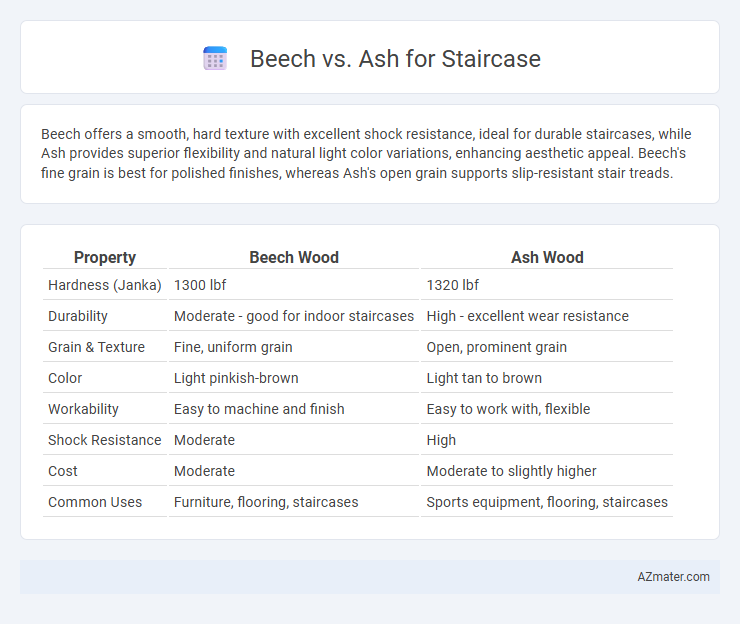Beech offers a smooth, hard texture with excellent shock resistance, ideal for durable staircases, while Ash provides superior flexibility and natural light color variations, enhancing aesthetic appeal. Beech's fine grain is best for polished finishes, whereas Ash's open grain supports slip-resistant stair treads.
Table of Comparison
| Property | Beech Wood | Ash Wood |
|---|---|---|
| Hardness (Janka) | 1300 lbf | 1320 lbf |
| Durability | Moderate - good for indoor staircases | High - excellent wear resistance |
| Grain & Texture | Fine, uniform grain | Open, prominent grain |
| Color | Light pinkish-brown | Light tan to brown |
| Workability | Easy to machine and finish | Easy to work with, flexible |
| Shock Resistance | Moderate | High |
| Cost | Moderate | Moderate to slightly higher |
| Common Uses | Furniture, flooring, staircases | Sports equipment, flooring, staircases |
Introduction to Beech and Ash Wood
Beech wood, known for its fine grain and light color, offers excellent hardness and durability, making it a popular choice for staircases that require both strength and aesthetic appeal. Ash wood is recognized for its flexibility and shock resistance, featuring a straight grain and pale hue that complements contemporary and traditional staircase designs. Both hardwoods provide superior wear resistance, but Beech tends to be denser, while Ash is often favored for its elasticity and natural beauty.
Key Characteristics of Beech Wood
Beech wood offers a dense and hard surface with exceptional strength, making it highly suitable for staircases that require durability and resistance to wear. Its fine, tight grain and pale creamy color give stair treads and balusters a smooth texture and an elegant, uniform appearance. Beech wood also responds well to staining and finishing, allowing for versatile design options while maintaining structural integrity.
Key Characteristics of Ash Wood
Ash wood offers high strength and exceptional shock resistance, making it ideal for staircases that require durability and long-lasting performance. Its light color with a straight grain pattern provides a natural, elegant look that complements various interior styles. Compared to beech, ash is more flexible and harder, which enhances its wear resistance and ability to withstand heavy foot traffic.
Durability: Beech vs Ash Staircases
Beech and ash both offer excellent durability for staircases, with beech being a hard, dense hardwood known for its resistance to wear and denting, making it ideal for high-traffic areas. Ash boasts exceptional shock resistance and flexibility, which contributes to its robustness and longevity in staircase construction. While beech provides a smoother grain and uniform texture, ash's superior strength and elasticity often result in enhanced durability under heavy use.
Aesthetic Appeal and Grain Patterns
Beech wood offers a smooth, fine grain with a pale cream color that darkens slightly over time, creating a warm and uniform appearance ideal for contemporary staircases. Ash features a more pronounced, straight grain with contrasting light and dark tones, providing a dynamic and visually striking effect suited for rustic or modern designs. Both hardwoods are valued for their aesthetic appeal, but Beech tends to deliver a softer, subtler look while Ash stands out with bold grain patterns and richer tonal variation.
Workability and Installation Differences
Beech wood offers excellent workability due to its fine grain and uniform texture, making it easier to shape and smooth for detailed staircase designs. Ash is slightly harder and more flexible, providing increased durability but requiring sharper tools and more precise handling during installation. Beech tends to require less finishing effort, while ash's natural elasticity demands careful fastening techniques to ensure stability on staircases.
Cost Comparison: Beech vs Ash
Beech staircases typically cost less than Ash due to the wood's faster growth rate and abundance, resulting in lower material expenses. Ash offers greater durability and a striking grain pattern, but its higher price reflects these premium qualities and slower availability. Choosing Beech or Ash depends on budget constraints and desired aesthetic, with Beech providing a cost-effective option and Ash positioned as a more investment-worthy material.
Maintenance and Longevity Factors
Beech wood offers moderate maintenance due to its dense grain, resisting dents and wear on staircases, while Ash provides superior durability with its higher shock resistance and flexibility. Ash staircases typically have a longer lifespan, enduring heavy foot traffic without significant damage, whereas Beech requires more frequent refinishing to maintain its appearance. Both woods benefit from regular sealing, but Ash's natural hardness reduces the need for intensive upkeep over time.
Environmental Impact and Sustainability
Beech and Ash wood both offer sustainable options for staircase construction, but Beech has a slightly higher environmental impact due to slower growth rates and less efficient carbon sequestration compared to Ash. Ash is known for its rapid growth and ability to regenerate quickly, making it a more renewable resource that supports forest sustainability. Choosing Ash for staircases reduces the carbon footprint and promotes responsible forestry practices, aligning with eco-friendly building standards.
Choosing the Right Wood: Beech or Ash for Your Stairs
Beech wood offers a fine, uniform texture with excellent shock resistance, making it ideal for staircases that require durability and a smooth finish. Ash features a lighter color and pronounced grain patterns, providing a more natural aesthetic while maintaining high strength and flexibility. Selecting between beech and ash depends on desired visual appeal and usage intensity, with beech favored for modern interiors and ash preferred for rustic or traditional settings.

Infographic: Beech vs Ash for Staircase
 azmater.com
azmater.com